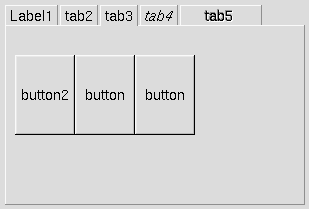
Fl_Group | +----Fl_Tabs
#include <FL/Fl_Tabs.H>
The Fl_Tabs widget is the "file card tabs" interface that allows you to put lots and lots of buttons and switches in a panel, as popularized by many toolkits.

Clicking the tab makes a child visible() by calling show() on it, and all other children are made invisible by calling hide() on them. Usually the children are Fl_Group widgets containing several widgets themselves.
Each child makes a card, and it's label() is printed on the card tab, including the label font and style. The selection color of that child is used to color the tab, while the color of the child determines the background color of the pane.
The size of the tabs is controlled by the bounding box of the children (there should be some space between the children and the edge of the Fl_Tabs), and the tabs may be placed "inverted" on the bottom, this is determined by which gap is larger. It is easiest to lay this out in fluid, using the fluid browser to select each child group and resize them until the tabs look the way you want them to.
Creates a new Fl_Tabs widget using the given position, size, and label string. The default boxtype is FL_THIN_UP_BOX.
Use add(Fl_Widget *) to add each child, which are usually Fl_Group widgets. The children should be sized to stay away from the top or bottom edge of the Fl_Tabs widget, which is where the tabs will be drawn.
The destructor also deletes all the children. This allows a whole tree to be deleted at once, without having to keep a pointer to all the children in the user code. A kludge has been done so the Fl_Tabs and all of it's children can be automatic (local) variables, but you must declare the Fl_Tabs widget first so that it is destroyed last.
Gets or sets the currently visible widget/tab.